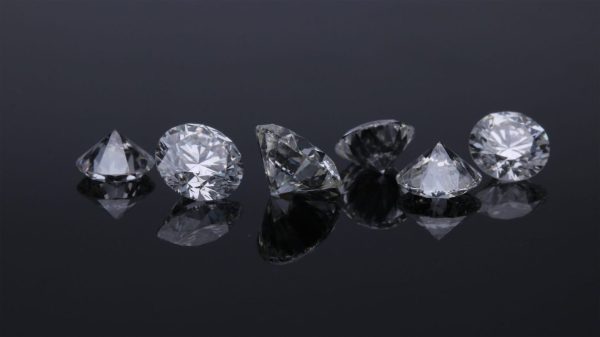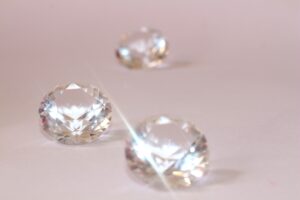
What Are Lab-Grown Diamonds? The Journey to Brilliant’s Perfection?
Lab-grown diamonds (also known as eco, synthetic, or engineered ones) are cultured in special laboratory environments using advanced equipment that mimics natural forming processes the brilliants undergo in the Earth’s mantel. They are composed of carbon dioxide atoms arranged in a typical crystal structure.
The Moment of Creation. How Magic Is Born
To understand how eco diamonds are made, we should first dive into the formation of organic diamonds. The latter appeared about 2 billion years ago in the earth’s crust, where they were exposed to extreme ground pressure and transported to the surface by extensive volcanic eruptions. The process of nurturing lab-grown equivalents is similar. The tiny carbon seeds of pre-existing diamonds are put under a large mechanical press that applies immense heat and crushing pressure.
Another way to synthesise diamonds is to put the seed in a sealed chamber overflown with carbon-rich gas heated to 800 C. Such high temperatures cause gas to cling to the seed and expand atom by atom. This technology was discovered only recently and is often referred to as CVD (Chemical Vapour Deposition).
Coloured Eco Diamonds Mystery
The biggest appeal of lab-grown brilliants is that they are available in an array of colours. The rainbow gamma is achieved by introducing alterations into the carbon gas mix. While this may sound simple, it took jewellers several years to perfect the technique and present you with refined shades of soft blue, light pink, canary yellow, etc.
Why Opt for Lab-Made Diamonds?
Lab-grown diamonds are a conscious choice because no shady practices are involved in their production. A few years ago, the mined brilliant industry was severely criticised and condemned by authorities for its unethical manufacturing procedures.
Diamonds became the product of conflict, and people massively refrained from their purchase. Thankfully, the Kimberley campaign in 2003 turned the tables around. The mined industry reduced the number of work exploitations, and approximately 99 % of organic crystals are now conflict-free.
Nonetheless, young couples gravitate towards engineered diamonds because they put customers’ minds at peace and give reassurance in companies’ transparent policies. Knowing the stone’s origin is the leading factor driving consumers’ demand up.
Enhanced Beauty and Polished Excellence
It may be hard to believe, but lab-grown diamonds are real diamonds. They possess the same physical, chemical and optical qualities as the organic ones and can not be distinguished from the latter with the unaided eye. In addition, lab-grown diamonds come closest to “flawless” stones.
The monitoring system and controlled facilities enable the crafting of symmetrical shapes without any blemishes.
Competitive Price
Synthetic diamond is the number one variant for price-conscious buyers. The sparkling luxury offers unique characteristics meanwhile preserving favourable value. No diamond is cheap, but a shorter supply chain allows to cut the overall cost by 30 %. Let’s see how it works.
Before organic brilliants are placed on the shopping window, they pass through the hands of miners, distributors, designers, artisans, manufacturers and finally, retailers. On the other hand, lab-made diamonds skip the mining process and limit the number of intermediaries. Ultimately, the stones are less expensive and more affordable. As companies begin to sell engineered gems and more labs are opened, the popularity of engineered diamonds is predicted to grow exponentially.
Fancy Rarity
Most jewellery stores display lab-grown diamonds in a variety of white ranges. However, they also sell the gems in enticing yellow, green and blue hues. Unlike the tinted organic stones, lab-grown won’t cost you an arm and a leg. You can get your partner a one-of-a-kind token and still have some budget left for the vacation.
Decreased Greenhouse Gas Emissions
According to scientific research conducted by the reputable Diamond Foundry, the environmental footprint of mined diamonds is several times bigger than that of synthesised diamonds. Extraction of underground crystals requires the consumption of substantial dirty energy amounts; meanwhile, the above-ground lab production is run on renewable sources only. The issue with organic diamonds is deeper than carbon emissions. The mining itself pollutes numerous water sources utilised by locals. Lab-grown diamonds help take that worry away.
Engineered Diamond vs Diamond Simulant
The principal distinction between lab-grown diamonds and diamond simulants lies in the structure. Diamonds simulants like cubic zirconia and moissanite resemble organic diamonds but don’t comprise carbon crystals. Moissanite is a particularly beloved choice among brides-to-be. They find this gem utterly symbolic because it was brought down from the sky. The stone particles were discovered in a crater created by meteorite hundreds of years ago. Let’s see how moissanite measures up against lab-grown diamonds.
| Properties | Moissanite | Lab-grown diamond |
| Brilliance (the ability to reflect light from the interior of the gem) | Bears a different brilliance and shines with rainbow flashes that may sometimes remind of the “disco ball.” | Shines with mesmerising silver flashes. The famous blink is the combination of white light, dispersion and scintillation |
| Sourcing | Mined | Mining-free |
| Colour | While moissanites are labelled “colourless”, they often acquire a greyish hue under certain angles. The more carats, the more distinct colouring | Crystal-clear, invisible |
| Durability (the ability to withstand banging and surface scratching) | Since moissanite rates 9.25 on the Mohs Scale of Hardness, it is suitable for everyday wear and tear. However, it’s less reliable than a diamond and requires careful treatment. | 10 out of 10 on the Mohs Scale of Hardness. Lab-grown diamonds will last a lifetime and carry your love message through eternity |
| Price | Moissanites cost dramatically lower than lab-grown diamonds, but they are not assessed with the 4 C’s system | Lab-grown diamonds cost more than any diamond simulants or other synthesised stones. However, their performance is too beyond compare |
Alternative Vs Mined
Seeing that lab-grown diamonds have the same physicochemical characteristics and exude the same fire and radiance as organic diamonds, the comparison boils down to your personal preferences. Without the needed equipment, you can’t differentiate engineered diamonds from natural ones. You may be inclined towards mined brilliants because they hold sentimental value and are one of the planet’s miracles. Or, you may choose synthesised diamonds because they represent contemporary relationships and the phenomenal progress of technology. Regardless of which stone you decide upon, it will be the most treasured gift by your partner. Love is love in all its manifestations.
Lab-Grown Diamonds Assortment
With the rapid development of the jewellery industry, more and more stores started embedding lab-grown diamonds into their collections. Synthesised gems are readily mounted in the most sought-after settings like pave, three stones, solitaire, halo and vintage. For most styles, accent diamonds match the selected centre stone. If you wish to improvise or have an idea of the ideal ring in your head, you can always turn to the “customise your band” feature.
Lab-Grown Diamonds Certification
Lab-grown diamonds are examined in the same manner as organic diamonds. Once the gem is formed, it gets transferred to an independent institution to be graded by a professional. The grading process revolves around the 4C’s ( cut, clarity, carat and colour).
Clarity refers to the absence of any flaws and blemishes. Colour determines the presence of yellowish or brownish hues. Carat indicates the weight of the stone, and the cut shows the precision of carving. The cut is arguably the most critical parameter because it impacts the general appearance and is directly connected to brilliance. Each property is thoroughly analysed and assigned a proper rating.
The most renowned institutions, GIA and IGI, both provide dedicated reports for lab-grown diamonds, specifying their origin in a small inscription.

